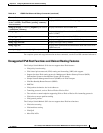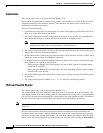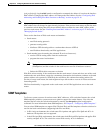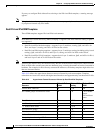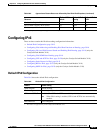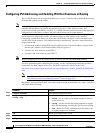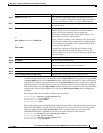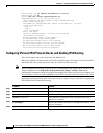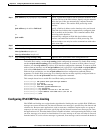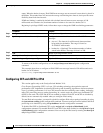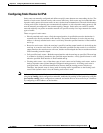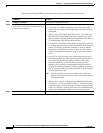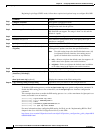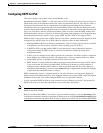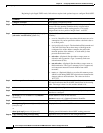
39-19
Cisco Catalyst Switch Module 3110 and 3012 for IBM BladeCenter Software Configuration Guide
OL-12189-01
Chapter 39 Configuring IPv6 Host Functions and Unicast Routing
Configuring IPv6
To disable IPv4 routing, use the no ip routing global configuration command. To disable IPv6 routing,
use the no ipv6 unicast-routing global configuration command. To remove an IPv4 address from an
interface, use the no ip address ip-address mask interface configuration command. To remove an IPv6
address from an interface, use the no ipv6 address ipv6-prefix/prefix length eui-64 or no ipv6 address
ipv6-address link-local interface configuration command. To remove all manually configured IPv6
addresses from an interface, use the no ipv6 address interface configuration command without
arguments. To disable IPv6 processing on an interface that has not been explicitly configured with an
IPv6 address, use the no ipv6 enable interface configuration command.
This example shows how to enable IPv4 and IPv6 routing on an interface.
Switch(config)# sdm prefer dual-ipv4-and-ipv6 default
Switch(config)# ip routing
Switch(config)# ipv6 unicast-routing
Switch(config)# interface gigabitethernet1/0/1
Switch(config-if)# no switchport
Switch(config-if)# ip address 192.168.99.1 244.244.244.0
Switch(config-if)# ipv6 address 2001:0DB8:c18:1::/64 eui 64
Switch(config-if)# end
Configuring IPv6 ICMP Rate Limiting
IPv6 ICMP rate limiting uses a token-bucket algorithm for limiting the rate at which IPv6 ICMP error
messages are sent to the network. The interval between error messages is specified in a time interval and
a bucket size. Because some applications, such as traceroute, sometimes require replies to a group of
requests to be sent in rapid succession, specifying only the interval between error messages can cause
the application to fail. The token bucket allows a number of tokens, each representing the ability to send
one error message, to be stored in virtual buckets. For every message to be sent, one token is removed
from the bucket. If a series of error messages is generated, error messages can be sent until the bucket is
Step 7
ipv6 address ipv6-prefix/prefix length eui-64
or
ipv6 address ipv6-address link-local
or
ipv6 enable
Specify a global IPv6 address with an interface identifier in the
low-order 64 bits of the IPv6 address. Specify only the network
prefix; the last 64 bits are automatically computed from the
switch MAC address. This enables IPv6 processing on the
interface.
Specify a link-local address on the interface to be used instead
of the link-local address that is automatically configured when
IPv6 is enabled on the interface. This command enables IPv6
processing on the interface.
Automatically configure an IPv6 link-local address on the
interface, and enable the interface for IPv6 processing. The
link-local address can only be used to communicate with nodes
on the same link.
Step 8
end Return to privileged EXEC mode.
Step 9
show interface interface-id
show ip interface interface-id
show ip v6 interface interface-id
Verify your entries.
Step 10
copy running-config startup-config (Optional) Save your entries in the configuration file.
Command Purpose



